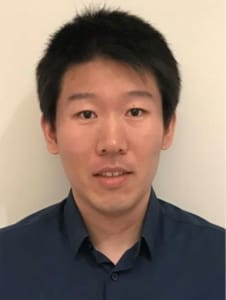
The Prostate Cancer Foundation Scholar-in-Training Awards recognize promising young cancer researchers presenting outstanding proffered papers relating to advanced prostate cancer at the American Association for Cancer Research (AACR) Annual Meeting. The Prostate Cancer Foundation is one of 18 organizations sponsoring this highly competitive awards program in conjunction with the AACR. The 2017 AACR Annual Meeting will be held from April 1 – 5, 2017 at the Walter E. Washington Convention Center in Washington, D.C.
 Seaho Kim, PhD
Seaho Kim, PhD
Weill Cornell Medicine, New York, NY
Abstract # 1590
High intranuclear mobility of AR-v7 reveals distinct mode of transcriptional activity in prostate cancer with important therapeutic implications
Seaho Kim, Mohd Azrin Jamalruddin, Paraskevi Giannakakou. Weill Cornell Medicine, New York, NY.
It is well established that androgen receptor (AR) signaling, is a key driver of prostate cancer (PC) growth and metastatic progression. Therefore, androgen deprivation therapy (ADT) is the first line of treatment for PC. However, most patients develop castration resistant prostate cancer (CRPC). Interestingly, AR signaling remains active in CRPC, due to the expression of transcriptionally active AR splice variants (AR-Vs), which lack the ligand binding domain (LBD) and constitutively translocate to the nucleus even in castrate conditions. AR-v7 is the most prevalent AR-V expressed in about 60% of CRPC tumors. AR-v7 expression was clinically correlated with poor prognosis of CRPC patients and with resistance to next- generation AR signaling inhibitors, which are part of standard clinical care. Therefore, inhibition of AR-v7 function is urgently needed for the treatment of CRPC. Currently, there is no therapeutic modality that can inhibit AR-v7 expression or activity. Mechanistically, AR-v7 transcriptional targets largely overlap with those of AR-fl, with the exception of a few AR-v7 unique targets. However, the exact mechanism by which transcription is activated by AR-v7 is not known. In this study we sought to investigate the mechanisms underlying the transcriptional activity of the ligand-independent AR-v7 in comparison to liganded AR-fl. We used live cell imaging to monitor the dynamics and intranuclear mobility of fluorescently-tagged AR-v7 or AR-fl. Fluorescent recovery after photobleaching (FRAP) revealed that AR-v7 intranuclear mobility was significantly faster than that of liganded AR- fl, with t1/2 3s versus several minutes, respectively. To precisely map the spatial distribution and chromatin- binding kinetics of AR-fl and AR-v7, we generated expression plasmids with AR tagged with green-to-red mEos4 photo-convertible proteins. Photoconversion of a discrete, subnuclear pool of AR-fl in the presence of its ligand (R1881) followed by 1 hr of time-lapse imaging in 5 min intervals, revealed absence of mobility indicating tight chromatin binding and active transcription. In contrast, similar photoconversion experiment for AR-v7, revealed immediate redistribution throughout the nucleus in less than 9 s, suggesting a “hit-and-run” mode of interaction with DNA with uncertain transcriptional output. QRT-PCR of endogenous target genes and ARE-mcherry reporter assays showed similar transcriptional activity of the two proteins. We are currently investigating the relationship between rates of intranuclear mobility and transcriptional activity and the mechanisms underlying the distinct mobility patterns. These data suggest that AR-v7 has a distinct mode of interaction with DNA and gene promoters, which may identify novel targetable pathways for its inhibition in CRPC.
This abstract will be presented in a Poster Session entitled Prostate Cancer Biology and Therapy on Monday, April 3, 2017, 8:00 am – 12:00 noon located in Poster Section 25, Poster Board 16.
 Haolong Li, MS
Haolong Li, MS
University of British Columbia, Vancouver, BC, Canada
Abstract # 1576
UGT2B17 promotes castration-resistant prostate cancer progression through enhancing ligand-independent AR signaling
Haolong Li1, Ning Xie1, Ruiqi Chen1, Mélanie Verreault2, Ladan Fazli1, Martin E. Gleave1, Olivier Barbier2, Xuesen Dong1. 1University of British Columbia, Vancouver, BC, Canada; 2Laval University, Québec, QC, Canada.
Background: Castration resistant prostate cancer (CRPC) is characterized by a shift of androgen receptor (AR) signaling from ligand-dependent to ligand-independent. Defining mechanisms that control AR signaling transformation is important to develop therapies for disease control. UDP-glucuronosyltransferase 2B17 (UGT2B17) is a key enzyme that maintains androgen homeostasis by catabolizing AR agonists into inactive forms. Although enhanced UGT2B17 expression by antiandrogens was reported in androgen-independent prostate cancers, its role in regulating AR signaling transformation and CRPC progression remain unknown.
Method and Results: We first evaluated the UGT2B17 protein expression levels by immunohistochemistry (IHC) on Vancouver Prostate Centre tissue microarrays. We show that higher UGT2B17 protein expression in prostate tumors is associated with higher Gleason score, metastasis and CRPC progression. The expression and activity of UGT2B17 are also higher in androgen-independent compared to androgen-dependent cell lines. Interestingly, enzalutamide-resistant MR49F cells expresses low UGT2B17 mRNA but strong protein expression, suggesting that posttranslational mechanisms may enhance UGT2B17 protein stability in these cells. We then constructed PCa cell lines with gain-of-function UGT2B17 by lentivirus. Functional analyses indicate that UGT2B17 stimulates cancer cell proliferation, invasion, and xenograft progression to CRPC after prolonged androgen deprivation. To further decipher the molecular mechanisms by which UGT2B17 enhance PCa cell growth independent of androgen, we performed gene microarray using LNCaP(mock) and LNCaP(UGT2B17) cells cultured under the regular serum condition or the prolonged androgen deprivation condition. Microarray analyses reveal that UGT2B17 suppresses androgen-dependent AR transcriptional activity, while enhancing androgen (ligand)- independent AR transcriptional activity. The latter targets genes associated with cell mitosis. These UGT2B17 actions in reprogramming androgen signaling are mainly mediated by activating the c-Src kinase. We confirmed that, in CRPC tumors, UGT2B17 expression is positively associated with c-Src activation.
Conclusion: These results indicate that UGT2B17 expedites CRPC progression by enhancing ligand-independent AR signaling that activates predominantly cell mitosis in cancer cells.
This abstract will be presented in a Poster Session entitled Prostate Cancer Biology and Therapy on Monday, April 3, 2017, 8:00 am – 12:00 noon located in Poster Section 25, Poster Board 2.
 Yingjie Xu, PhD
Yingjie Xu, PhD
Boston Children’s Hospital, Harvard Medical School, Boston, MA
Abstract # 1231
Restoration of tumor suppression in vivo by systemic delivery of PTEN mRNA nanoparticles
Yingjie Xu1, Mohammad Ariful Islam2, Harshal Zope2, Morteza Mahmoudi2, Robert S. Langer3, Jinjun Shi2, Bruce R. Zetter1, Omid C. Farokhzad2. 1Boston Children’s Hospital, Harvard Medical School, Boston, MA; 2Brigham and Women’s Hospital, Harvard Medical School, Boston, MA; 3Massachusetts Institute of Technology, Cambridge, MA.
PTEN (phosphatase and tensin homolog on chromosome ten) is one of the most common lost or mutated tumor suppressor genes in human cancers, including ~50% of metastatic castration-resistant prostate cancer (mCRPC). By catalyzing PIP3 dephosphorylation, PTEN negatively regulates the PI3K-AKT-mTOR pathway, which is frequently altered in mCRPC. Reintroduction of functional PTEN for mCRPC treatment has proven difficult. By employing self-assembled lipid-polymer hybrid nanoparticle platforms, we successfully reintroduced PTEN mRNA to PTEN-null prostate cancer cells both in vitro and in vivo. These mRNA-loaded nanoparticles demonstrate high protein expression efficiency, low toxicity and good stability in serum and tumor accumulation. We confirmed that restoration of PTEN in PTEN-null prostate cancer cells inhibits the PI3k-AKT pathway, reduces cell viability and enhances apoptosis in vitro. Systemic delivery of PTEN mRNA-loaded nanoparticles in prostate xenograft tumors results in ~85% inhibition of tumor growth and leads to tumor cell death without toxic side effects in vivo. In summary, this work provides proof of concept of mRNA-based gene therapy for systemic restoration of functional PTEN for tumor suppression in vivo. It represents a novel approach to PI3K-AKT pathway inhibition, with the potential to specifically target cancers with loss of PTEN function.
This abstract will be presented in a Poster Session entitled Targeting Growth Factor and Intracellular Signaling on Monday, April 3, 2017, 8:00 am – 12:00 noon located in Poster Section 7, Poster Board 16.









